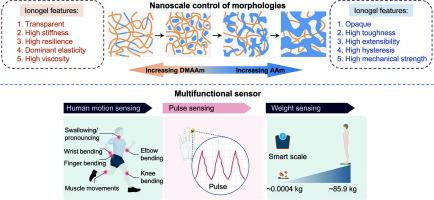Nanoscale control of morphologies enables robust and elastic ionogel for sensitive and high-resolution pressure sensing over wide linear range
IF 13.3
1区 工程技术
Q1 ENGINEERING, CHEMICAL
引用次数: 0
Abstract
Ionogel, an excellent biomimetic sensing material due to high stability and wide operating temperature range, holds substantial promise for wearable devices, while still possesses big challenges in integration of desirable mechanical properties and sensing performance via straightforward strategies. Here, a tailored ionogel with tissue-matched softness (Young’s modulus <10.7 ± 0.8 kPa), appropriate adhesion, remarkable compression resistance (>1 MPa), resilience and sensing reliability by copolymerizing two homologous monomers of acrylamide and N,N-dimethylacrylamide in 1-ethyl-3-methylimidazolium trifluoromethanesulfonate is developed by phase separation. Through fine adjustment of components, nanoscale transformation of microstructures from nanoporous structure to island structure, followed by bicontinuous structures results in distinct impact on optical, thermal, mechanical, and conductive properties of ionogels, and the intricate effects of phase-separated degree on nanoscale structural features and macroscopic performance have been revealed. The resultant ionogels are readily manufactured to versatile sensors for precise detection of body signals from subtle pulse to large body weights, achieving low detection limit (8 Pa), high pressure resolution (0.055 %) and good sensitivity (1.2 kPa−1) over a broad linear range (0.008–1000 kPa), together with rapid response speed of tens of milliseconds and recovery speed of ∼20 s under extreme compression. This work delves into essential correlation between nanostructures of ionogel and its properties, and we expect the approach of tailoring functions of soft matter by hierarchical structures to provide guidance for future fabrication of flexible sensors in target applications.

求助全文
约1分钟内获得全文
求助全文
来源期刊

Chemical Engineering Journal
工程技术-工程:化工
CiteScore
21.70
自引率
9.30%
发文量
6781
审稿时长
2.4 months
期刊介绍:
The Chemical Engineering Journal is an international research journal that invites contributions of original and novel fundamental research. It aims to provide an international platform for presenting original fundamental research, interpretative reviews, and discussions on new developments in chemical engineering. The journal welcomes papers that describe novel theory and its practical application, as well as those that demonstrate the transfer of techniques from other disciplines. It also welcomes reports on carefully conducted experimental work that is soundly interpreted. The main focus of the journal is on original and rigorous research results that have broad significance. The Catalysis section within the Chemical Engineering Journal focuses specifically on Experimental and Theoretical studies in the fields of heterogeneous catalysis, molecular catalysis, and biocatalysis. These studies have industrial impact on various sectors such as chemicals, energy, materials, foods, healthcare, and environmental protection.
 求助内容:
求助内容: 应助结果提醒方式:
应助结果提醒方式:


